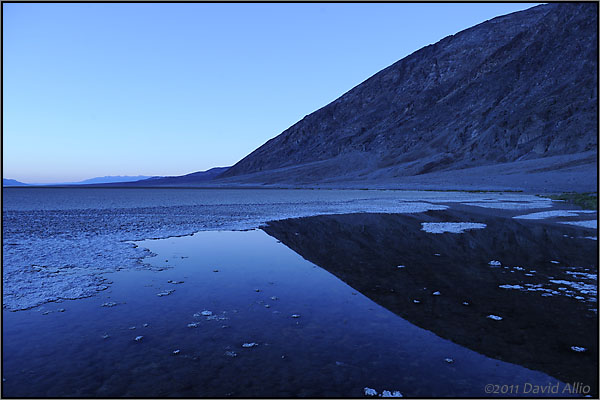Death Valley, California, is a place of extremes. The brutal summer sun and intense heat of the Mojave Desert bake most of the vivid color from the landscape. In bright sunlight the dull tans contrast with the bright blue sky. After sunset, and before dark, the dull tans become duller grays, a situation perfect for even duller photographs.
One of the contrasts in the 156-mile-long depression that sits between the Amargosa Mountain Range on the east and the Panamint Mountain Range on the west is that water actually exists in Death Valley. Badwater is 282 feet below sea level and it is the lowest place in the Western Hemisphere.

Badwater Basin at Dusk | ©2011 David Allio
So, how is it possible to create excitement from dull and color from gray?
One solution is to borrow a technique from the school of film photography and the era of screw-in color compensating filters. Underexpose by between one-third and two-thirds of an f/stop to increase whatever color saturation is available. Then use a filter to add color – in this case blue to represent the water.
Just because the in-camera electronics say so does not always mean it is the correct or most creative way to present a scene. Usually the in-camera information is an average or sometimes a biased average of the information provided to the evaluation systems. My goal is not to make average pictures. I want my photographs to stand out from the average. And in this era of immediate results and intense deadline pressures, if a photograph does not come out of my camera the way I want it presented, there rarely is an opportunity to correct or enhance the image later – hence the mantra: “Do it right, right now.
This is the original color digital version of this photograph of Badwater Basin in Death Valley. It was created using Nikon D3 camera equipped with an AF-S Nikkor 24-70mm 1:2.8G ED lens. With the focal length set at 24mm the exposure settings were an aperture of f/5.6, shutter speed of 1/160th second, and film speed 400 ISO. The actual exposure for this after-sunset photograph was two-thirds of a stop under what was recommended by the in-camera meter. The white balance in the camera was set for about 5000K less that the actual ambient light.
You must be logged in to post a comment.